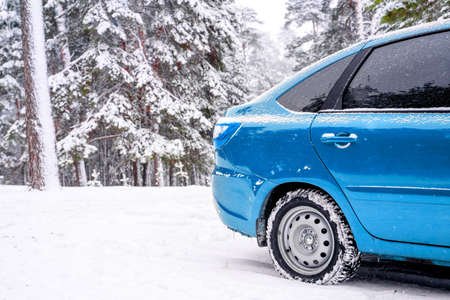Understanding the British Winter: What Makes It So Challenging for Drivers
There’s something unmistakably nostalgic about a British winter—the distant hum of gritters on the road, the crackle of frost on an old windscreen, and the persistent dampness that creeps into every nook and cranny of our beloved motors. Unlike harsher, snow-laden climates elsewhere, the UK’s unique blend of chilly drizzle, relentless salt spreading, and unpredictable cold snaps gives our winters a character all their own—one that’s both endearing and exasperating for drivers, especially those with a soft spot for classic vehicles.
British winters are notorious not just for their cold, but for their particular brand of wet and salty adversity. The combination of high humidity, regular rainfall, and frequent overnight frosts creates an environment where even the sturdiest car can suffer. This isn’t just about snow; it’s the way moisture lingers in the air and clings to metalwork, while salt from gritted roads accelerates corrosion at an alarming pace. And let’s not forget the icy mornings when you’re scraping frost off your windscreen with an old loyalty card because you’ve misplaced your proper scraper again—a true rite of passage for any UK motorist.
| Winter Element | Impact on Vehicles |
|---|---|
| Damp Cold | Promotes rust in bodywork and electrical issues due to moisture ingress |
| Road Salt | Accelerates corrosion on chassis, wheel arches, and exhausts |
| Persistent Frost | Leads to frozen locks, stiff doors, cracked rubber seals, and foggy windscreens |
This quirky climate means that vehicle maintenance takes on almost ritual importance during the winter months. Whether you’re keeping a cherished old Mini ticking over or just trying to coax your daily runner through another season, understanding these uniquely British challenges is the first step towards keeping your pride and joy safe from Jack Frost’s mischievous touch.
2. Classic British Tips for Preventing Frost on Windscreens and Windows
Drawing from a rich tapestry of motoring heritage, British drivers have long relied on a blend of practical wisdom and time-tested techniques to fend off frost during the chilly winter months. While modern solutions abound, there’s something uniquely satisfying about using classic methods that harken back to simpler times. Below, we explore some of the most effective ways—both old and new—to keep your windscreen and windows crystal clear, ensuring safe journeys whatever the weather throws your way.
The Essential British Arsenal: Covers, Cardboard, and More
One of the oldest tricks in the book is the humble windscreen cover. Whether it’s an off-the-shelf insulated variety or a makeshift solution fashioned from an old blanket or even yesterday’s newspaper, a well-placed cover can make all the difference come frosty morning. For those with a penchant for nostalgia, many recall their grandparents laying flattened cardboard boxes over car windscreens—a method that remains surprisingly effective today.
| Method | Description | Pros | Cons |
|---|---|---|---|
| Windscreen Cover | Purpose-made or DIY covers placed overnight | Easy to use; reusable; protects glass and wipers | Can be blown off by strong winds if not secured properly |
| Cardboard/Blanket | Old-fashioned barrier using household items | Cost-effective; readily available; nostalgic charm | Can absorb moisture; may freeze to glass if damp |
| Newspaper Sheets | Layered under wipers for temporary protection | Cheap and disposable; quick solution in a pinch | Tears easily; not ideal in heavy snow or rain |
Avoiding Costly Mistakes: What Not to Do According to Old Hands
No discussion would be complete without heeding the advice passed down through generations: never pour boiling water over a frozen windscreen! This shortcut can crack glass instantly—an expensive lesson learnt by many a young driver. Instead, stick to tried-and-true remedies like de-icer sprays (for those who prefer modern convenience) or simply running your car’s heater gradually while gently scraping away ice with a proper plastic scraper.
The Vinegar Solution: A Vintage Hack Still Trusted Today
An old wives’ tale that holds some merit involves mixing three parts vinegar with one part water and spraying it on your windscreen the night before. This simple concoction helps prevent ice from sticking, making morning clear-ups easier—just be sure to avoid getting it on paintwork as repeated use may dull the finish.
Nostalgic Final Tip: Keep a Spare Pair of Gloves in the Glovebox!
No matter which method you favour, nothing beats slipping on a warm pair of gloves before braving the cold. As any seasoned British motorist will tell you, comfort is key when tackling winter’s challenges—and there’s no shame in channelling your inner granddad for a bit of old-school ingenuity.

3. Caring for Bodywork and Undercarriage Against Salt and Grit
Relive the days of underseal and mudflaps as we examine how road salt eats away at classic Fords and Morris Minors alike, and how modern and traditional methods can keep rust at bay. During the British winter, local councils liberally spread salt and grit on our roads to keep us moving safely. While it’s a blessing for motorists, it’s a slow disaster for your car’s bodywork—especially if you’re lucky enough to drive a cherished classic or older motor. The salty slush clings to sills, wheel arches, and undersides, quietly gnawing away at metal as soon as you park up after your commute.
The Perils of Salt and Grit
Salt accelerates corrosion by lowering the freezing point of water, allowing dampness to linger in nooks and crannies. Even robust old workhorses like Land Rovers and Cortinas aren’t immune—rust worms its way into seams, suspension mounts, and exhaust hangers. Here’s a quick look at how different areas of your car are affected:
| Vulnerable Area | Common Problems |
|---|---|
| Wheel Arches | Pitting, bubbling paint, structural rust |
| Sills & Floor Pans | Perforation, weakened structure |
| Undercarriage | Exhaust rot, brake line corrosion |
Classic Solutions: Underseal & Mudflaps
Many old-school British enthusiasts swear by the annual ritual of applying underseal—a thick, tar-like coating that shields vulnerable metal from muck. Fit a good set of period-correct mudflaps, too; not only do they evoke memories of 1970s winters but also deflect much of the worst debris away from bodywork.
Modern Rust Prevention Methods
Nowadays, there’s an arsenal of more advanced products available. Wax-based sprays like Waxoyl or Dinitrol creep into seams and box sections far more effectively than old-style bitumen underseal. Ceramic coatings offer additional protection for paintwork, making it harder for salt-laden grime to stick in the first place.
Maintenance Tips for Every Motorist
- Rinse your car’s undercarriage with fresh water every week during winter—especially after long motorway runs or trips through gritted lanes.
- Inspect wheel arches and sills regularly for early signs of rust; deal with any chips or scratches immediately using touch-up paint.
- If you own a classic or plan to keep your car long-term, consider professional rustproofing treatments before winter sets in.
A little care goes a long way—whether you’re preserving a beloved Minor or simply want to keep your daily runner looking sharp through another British winter.
4. Classic Car Battery Care in the Cold
Drawing on practical wisdom from the glory days of British motoring, every seasoned enthusiast knows that winter is a true test of a car’s character—especially when it comes to the battery. Back in the heyday of Triumphs and MGs, batteries often struggled as mercury dipped below zero. The combination of cold temperatures and increased electrical demand (think headlights, heaters, and demisters working overtime) made frosty mornings infamous for their reluctant starts. Understanding these age-old challenges can help modern classic owners keep their pride and joy running whatever Jack Frost throws our way.
Why do batteries suffer in the cold? It’s simple: chemical reactions slow down, reducing available cranking power just when you need it most. Old Lucas batteries, as any classic owner will tell you, could be temperamental even on a mild autumn day—let alone during a Midlands cold snap. To ensure your classic starts reliably through the British winter, a blend of nostalgia-driven know-how and practical care is essential.
| Winter Battery Challenge | Classic Solution | Modern Tip |
|---|---|---|
| Reduced Cranking Power | Park facing downhill for an easy bump start | Invest in a trickle charger or battery maintainer |
| Corroded Battery Terminals | Scrub with bicarbonate of soda and hot water | Apply terminal grease to prevent further corrosion |
| Batteries Losing Charge Overnight | Disconnect negative lead if storing for days at a time | Use an isolator switch for convenience and security |
| Brittle or Perished Cables | Check cables regularly—replace with period-correct wiring if needed | Upgrade to heavy-duty leads for improved reliability |
Top Tip: Always check electrolyte levels in traditional lead-acid batteries; top up with distilled water as needed—just like old hands did at roadside garages from Kent to Cumbria.
Remember: A battery blanket or even an old rug draped over the engine bay overnight can make all the difference on those sub-zero mornings. And for those who cherish originality but want peace of mind, consider hiding a modern AGM or gel battery inside an authentic-looking case—nobody at the next classic meet will ever know.
5. Ensuring Tyres and Brakes Are Ready for the Icy Commute
As any classic motor enthusiast will tell you, reliability starts from the ground up—especially when the British winter lays down a frosty challenge. In years gone by, drivers would religiously check their tyres and brakes before venturing onto icy lanes and winding B-roads. Today, that wisdom rings truer than ever. Keeping your vehicle sure-footed in wintry conditions requires attention to detail reminiscent of a bygone era, where preparation was as much a ritual as it was a necessity.
Tyre Checks: The Foundation of Winter Safety
The right set of tyres can mean the difference between gripping the tarmac or skidding into the verge. It’s not just about having enough tread; it’s about ensuring every aspect is up to scratch. Below is a handy table, inspired by workshop checklists of old, to guide your inspection:
| Tyre Check | What to Look For | Classic Tip |
|---|---|---|
| Tread Depth | At least 1.6mm (ideally 3mm in winter) | Use a 20p coin to check; if the border is visible, it’s time for new tyres |
| Tyre Pressure | Refer to owner’s manual for correct PSI | Check when tyres are cold, just like in the good old days at the petrol station |
| Sidewall Condition | No cracks or bulges | A quick visual inspection before every drive pays dividends |
Inflation: More Than Hot Air
A tyre properly inflated according to manufacturer specs ensures even wear and maximum grip—a lesson learned by generations past who knew that under- or over-inflation could spell disaster on black ice. Modern digital gauges make this task simple, but don’t underestimate the value of a trusty analogue gauge tucked away in your glovebox.
Brake Maintenance: Stopping Power You Can Trust
Brakes are your last line of defence against winter’s unpredictability. Regular checks harken back to those pre-motoring days when drivers would adjust drum brakes in their sheds before setting out. In today’s context:
- Have brake pads and discs inspected for wear—any squealing or grinding means immediate attention is needed.
- Check brake fluid levels and top up with the recommended DOT fluid.
- If you own a classic car with drum brakes, ensure they’re correctly adjusted and free of moisture.
Nostalgic Note: The Pre-Winter Service Ritual
A tradition worth reviving is the pre-winter service—a thorough once-over that brings peace of mind as temperatures drop. Book in with your trusted local garage, or roll up your sleeves and channel those hands-on skills passed down through generations. With well-cared-for tyres and brakes, you’ll be ready to tackle whatever Jack Frost throws at you on those crisp British mornings.
Traditional Garage and Driveway Solutions for Snow and Ice
When it comes to protecting your vehicle during the unforgiving British winter, sometimes a nod to the past offers surprisingly effective solutions. In the days of coal-fired heaters and classic motorcars, motorists had their own ways of keeping frost, snow, and ice at bay. Today, while technology has advanced, many traditional methods—paired with modern upgrades—remain relevant for safeguarding your cherished vehicle.
Revisiting Classic Heating Methods
In post-war Britain, heated garages were a luxury. Some enthusiasts would place a small paraffin or electric heater in their garage overnight to prevent frost from forming on windscreens and engine blocks. While coal-fired solutions are now a relic of the past due to environmental concerns, modern electric fan heaters or oil-filled radiators can still provide gentle warmth—just ensure proper ventilation and fire safety.
Comparing Old vs. Modern Garage Heating
| Method | Era | Pros | Cons |
|---|---|---|---|
| Coal/Paraffin Heater | 1940s-1960s | Effective heat, low cost (then) | Fire risk, fumes, not eco-friendly |
| Electric Fan Heater | Present Day | No fumes, safer operation | Higher running cost, needs power supply |
Driveway Strategies: Then and Now
The classic method of laying down straw or old sacks on the driveway offered insulation against overnight frost. Today, you might opt for insulated car covers or even heated driveway mats for a more high-tech solution. Gritting the drive with rock salt remains a staple in British households—just as it was decades ago.
Driveway Solutions Table
| Solution | Description | Best For |
|---|---|---|
| Sacks/Straw Covering | Covers ground to reduce frost build-up | Nostalgic touch, light frosts |
| Insulated Car Covers | Protects car directly from snow & ice | Modern vehicles, exposed locations |
| Heated Mats | Mats that melt snow/ice on contact | Paved driveways prone to heavy snow |
Making the Most of Your Carport or Garage
If you’re fortunate enough to have a carport or garage—a rarity in some parts of Britain—keeping doors closed at night helps trap warmth. Ensure gaps are sealed to block draughts but allow for minimal airflow to prevent condensation. Installing basic insulation or rubber seals is an easy weekend job that pays dividends during cold snaps.
Nostalgic Tip:
A classic trick from yesteryear: place a thick piece of cardboard under your engine bay overnight. It soaks up moisture and acts as an insulating barrier between your car and the freezing ground—a simple yet effective hack from Britain’s golden motoring age.


